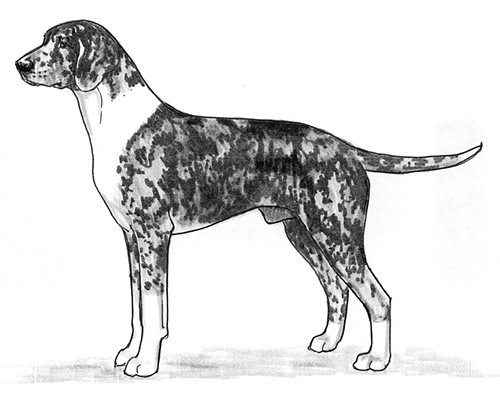Dunker
Scenthound Group
The goals and purposes of this breed standard include: to furnish guidelines for breeders who wish to maintain the quality of their breed and to improve it; to advance this breed to a state of similarity throughout the world; and to act as a guide for judges.
Breeders and judges have the responsibility to avoid any conditions or exaggerations that are detrimental to the health, welfare, essence and soundness of this breed, and must take the responsibility to see that these are not perpetuated.
Any departure from the following should be considered a fault, and the seriousness with which the fault should be regarded should be in exact proportion to its degree and its effect upon the health and welfare of the dog and on the dog’s ability to perform its traditional work.
History
The Dunker originated in Norway.
The Dunker was recognized by the United Kennel Club January 1, 1996.
General Appearance
Medium sized, short haired, rectangular shaped scenthound that should appear powerfully built, but not heavy or cumbersome.
Head
The head is clean and noble. It is long, with parallel planes of the skull and muzzle. It is not wedge shaped. The head is to be carried fairly low.
SKULL
Slightly domed, with a prominent occiput. The stop is defined, but not steep or abrupt. The cheeks are clean.
MUZZLE
The muzzle is rather long and square cut. The nasal bridge is straight and broad.
TEETH
The Dunker has a complete set of evenly spaced, white teeth meeting in a scissors bite.
NOSE
The nose is black, with wide nostrils.
EYES
Rather large and round, but not protruding, the eyes are dark in color.
EARS
The ears are set rather low. They are wide and flat, hanging close to the head. They should reach to the middle of the muzzle when pulled forward.
Neck
Rather long, with no throatiness.
Forequarters
The shoulder blades are muscular, long and sloping, meeting closely at the tips. They are well angulated with the upper arms.
FORELEGS
The legs are straight, strong and sinewy. The distance from the elbow to the ground is one half the height at the withers. The pasterns are slightly sloping.
Body
The chest is capacious, and the ribs are well sprung. The back ribs especially should be well developed and long. The topline is level and the back is straight, firm and not too long. The loin is broad and muscular but not arched. The croup is slightly sloping. There is a slight tuck up.
Hindquarters
The hindquarters are well angulated.
HIND LEGS
The thighs are broad, and the stifle is well angulated. The hocks are dry, broad and low set.
Feet
Arched and well knit, with firm pads. They should be well covered with hair between the toes. The feet should point straight ahead.
Tail
Set on level with the topline, the tail is strong at the root and tapers towards the end. It should be straight and be carried in a slight upward curve. At rest the tail should reach to the hock.
Coat
Straight, hard, dense and not too short.
Color
Black or blue marbled (dappled), with pale fawn and white markings. Warm brown or predominant black reaching from the muzzle and beyond the hock joint with so-called black mask is less desirable. Over-marked white where the white colour reaches out on the shoulders, on the underside of the belly and on legs (socks) is accepted as correct marking.
Disqualification: Body color that is more than 50% white.
Height and Weight
Height at the withers for males is 19.5 to 21.5. For females, it is 18.5 to 20.5.
Gait
Free and ground covering, parallel from behind. Never crouched or cow hocked.
Disqualifications
(A dog with a Disqualification must not be considered for placement in a conformation event, and must be reported to UKC.)
Unilateral or bilateral cryptorchid.
Viciousness or extreme shyness.
Albinism.
Body color that is more than 50% white.

Looking for a Dog?
Find a dog that will fit your family.
Note: The breeders on this list are not endorsed by UKC.
©Copyright 1996, United Kennel Club
